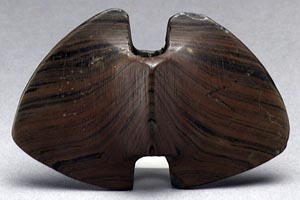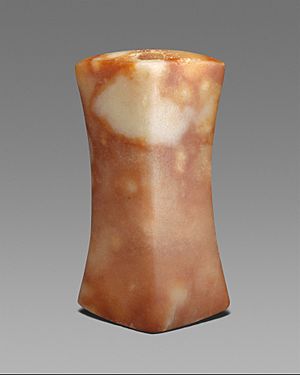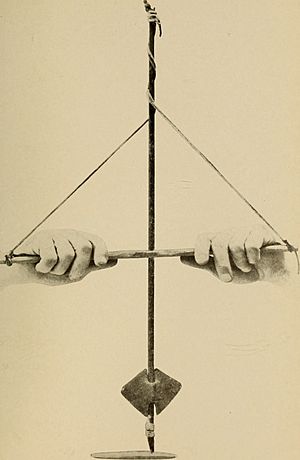Bannerstone facts for kids


Bannerstones are ancient tools or objects found mostly in the Eastern United States. They are special because they have a hole in the middle of a carefully shaped stone. These holes are usually about 1⁄4" to 3⁄4" wide. Many bannerstones are made from colorful stones like banded slate. They often look like "wing nuts" or "butterflies," but they come in many different shapes and designs. Bannerstones were more than just tools; they were also a form of art, showing their importance in ceremonies and spiritual beliefs.
Contents
What Were Bannerstones Used For?
Archaeologists, who study ancient human history, have long discussed what bannerstones were used for. Some think they were weights for a atlatl, which is a tool used to throw spears. Others believe they might have been used for drilling, making ropes, or even starting fires.
One idea, from Robert S. Berg, was that bannerstones were part of a tool kit for making and fixing atlatl darts. However, many experts disagreed with this idea. Earlier, William S. Webb suggested that bannerstones were actually part of the atlatl itself. He found bannerstones next to atlatl handles and hooks in ancient graves. These graves were found during the construction of the Tennessee Valley Authority projects in the early 1900s.
It seems that bannerstones were valued more for their meaning and beauty than just for being a tool. This is because of how carefully they were made and how they were found in ancient sites.
Why Were Bannerstones So Important?
The ceremonial importance of bannerstones is linked to the challenges of daily life for early hunters and gatherers. These people relied on the power of the stones, their creators, or their gods for protection. They also sought help from nature to survive the tough life of the Archaic Period.
For example, hunters would want protection from danger while hunting. They would also give thanks and recognize the powers that guided their spears thrown from atlatls. This would help them succeed in their hunts.
As mentioned in a book called Hero, Hawk, and Open Hand, bannerstones were very well made. Their materials suggest they were also symbols of importance and status for young hunters. They might have been seen as lucky charms to make spear-throwing more effective. They could also have been symbols for different family groups or social units. This shows that bannerstones had complex symbolic roles in society, beyond just helping with hunting.
The Story of Bannerstones Through Time
Bannerstones tell us that the societies that made them were more organized than earlier groups. They also suggest that different tribes in various regions depended on each other more. Brian M. Fagan, an archaeologist, explains that making detailed bannerstones made sense if they were used in large trade networks. These networks helped form alliances between groups.
These alliances made life more secure for ancient people. They helped them deal with unpredictable food sources. So, bannerstones can show us how different societies were connected through trade. This trade could involve the stone itself, the finished bannerstone, or even its design. New ideas often mixed with old beliefs, leading to unique art forms like bannerstones.
People in the Mid-Archaic period started putting more effort into making beautiful objects like bannerstones. These were used in trade and to form alliances. Bannerstones were not just for physical survival. They were also important for spiritual well-being. They were part of a larger system of beliefs that connected different groups of people in the eastern woodlands.
The Laurentian Period and Bannerstones
The Laurentian period was a time in the Late Archaic era, from about 3200 BC to 1000 BC. This period covers a region from New England to Quebec, and down into Pennsylvania and New Jersey. The ancient people in this area during this time were known for making polished bannerstones.
When Bannerstones Were No Longer Used
Bannerstones eventually stopped being used. This happened as new technologies, like the bow and arrow, became popular. The bow and arrow appeared around or before 500 AD and spread through trade routes. Even though bannerstones were no longer used as tools, their ceremonial and spiritual importance continued. This importance was simply transferred to the new objects that replaced them.
Important Discoveries of Bannerstones
One important ancient site with many graves containing bannerstones is called Indian Knoll in Kentucky. At this site, many bannerstones were found that showed no signs of being used. They were carved from special stones brought from far away. They showed amazing artistry, using the natural colors and patterns of the stones to look beautiful.
This shows two things:
- How important long-distance trade was in connecting different ancient societies.
- How much these societies valued the visual beauty of these objects.
This beauty was partly created to please the spirits. People hoped these spirits would help and protect them in hunting, in society, and in the world around them.


